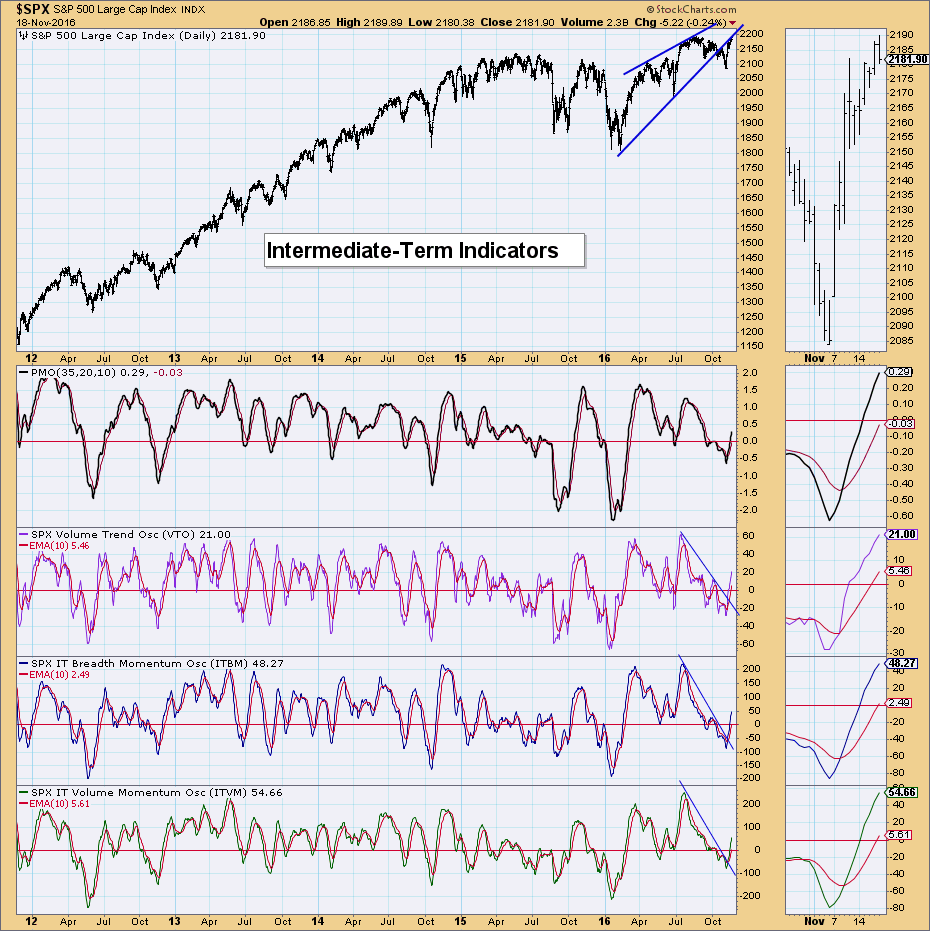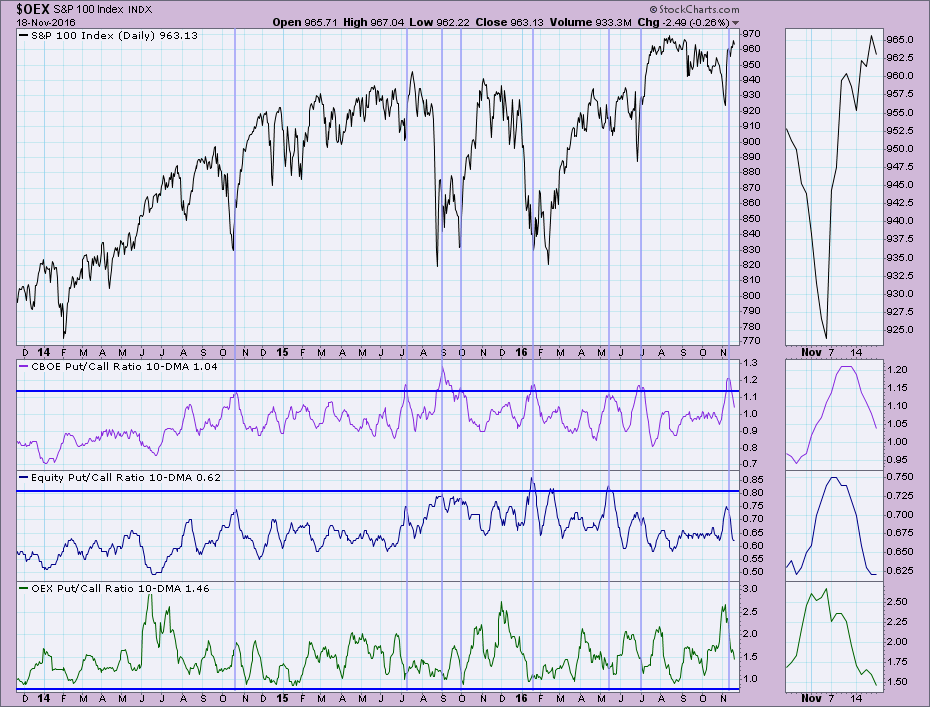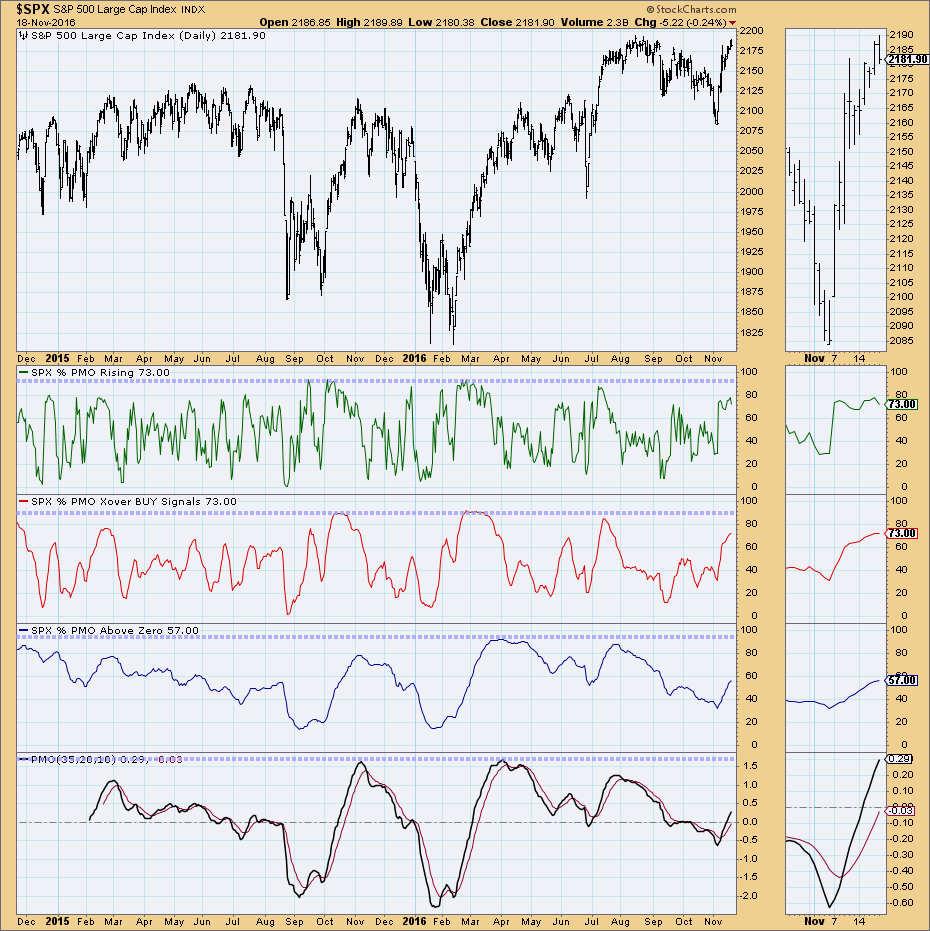|
|
||||
 |
||||
Expert Technical Commentary Delivered Straight To Your Inbox |
||||
| November 19, 2016 | ||||
Hello Fellow ChartWatchers!Welcome to the latest edition of ChartWatchers, the newsletter for technical analysts, online investors, StockCharts users and more. In addition to this week's articles don't forget to check out the Site News section towards the bottom of the newsletter. Enjoy! Having trouble viewing this email? |
||||
|
My October 6 market message suggested that the Japanese yen was peaking which would give a boost to export-oriented Japanese stocks which appeared to be bottoming. Since then, the yen has fallen to the lowest level in six months against the dollar, and has fallen below its 200-day average (Chart 1). At the same time, the lower box shows the Nikkei 225 Index rising to the highest level since January (based on today's higher close). But that's only part of the story. That earlier message explained that foreign investors (like Americans) buying Japanese stocks need to hedge out the negative effects of a falling yen. As explained at the time, the easiest way to do that is through the Wisdom Tree Japan Hedged Equity ETF (DXJ).
|
||||
|
||||
 |
||||
|
The market began its move to riskier assets in July and this move simply accelerated over the last two weeks. The chart below shows stocks (risk assets) bottoming in late June and Treasury bonds (safe-haven assets) peaking in early July. The S&P 500 SPDR (SPY) hit a new high this week and the 20+ YR T-Bond ETF (TLT) is trading at its lowest level since January. The indicator window shows the price relative (SPY:TLT ratio) bottoming in February, forming a higher low in early July and surging to its highest level since summer of 2015. This means stocks are outperforming T-bonds and this reflects a strong risk appetite in the US markets. This strong risk appetite is also reflected in sector performance since July. The Utilities SPDR (XLU) and Consumer Staples SPDR (XLP) also peaked in the first part of July and both are down sharply over the last four months. Conversely, three of the four offensive sectors are leading the market with bigger gains than SPY, which is up 4.84% over the last 100 days. Notice that the Finance SPDR (XLF), Technology SPDR (XLK) and Industrials (XLI) are up the most of the nine sectors and clearly leading. The Consumer Discretionary SPDR (XLY) which represents the fourth offensive sector, is up less than SPY and still lagging. Nevertheless, three out of four is enough to support a bull market. XLY is the cyclicals sector in this PerfChart.
Plan your Trade and Trade your Plan |
||||
|
||||
|
The long term chart for the $CRB continues to be a worry for technicians like me trying to understand why Commodities are having trouble staying above the 45 year trend line. Oil reached lows around $10-$12 in the 2000 period whereas now the oil low was $25. Currently oil is at $46 and this long-term commodity chart is barely holding the long term trend. The question that needs to be asked is what is changing the long-term trend in commodities that suggests the historical support level is not longer support? With the US Dollar ($USD) rising, this typically puts more pressure on commodities. While there is lots of noise around what might or might not be correlated with the $USD, over longer time frames commodities underperform with the US Dollar as a headwind. When the charts are making new lifetime lows for current investors, history might not be the best guide. The changes in energy supply with solar, wind and wave energy may be affecting the big picture. Nuclear, natural gas abundance, and energy efficiency are all contributing to the pressure. Even the ethanol from corn comes under pressure as the costs of other types of energy drops. With the extreme weakness in the commodity chart, something seems to be changing in the macro picture. This does not appear to be business as usual for the commodity charts. The next year could be a mystery for fundamental investors but technical investors have the best view of how the macro is changing. Buyer beware. Investors may be better off finding other areas of the market that have high beta to invest from the long side until the dark clouds of the US Dollar clear up for commodities. Good trading, |
||||
|
||||
 |
||||
|
The Russell 2000 is a small cap index and it had been lagging for quite awhile....until 2016. This year the Russell 2000 is wildly outperforming the S&P 500 and now we're heading into December, its most bullish calendar month of the year by far. Since 1987, the Russell 2000 has produced annualized returns of 38.49% during the upcoming month and December has risen 25 times while declining just 4 times. Clearly, December is the sweet spot for small cap stocks. Here's a look at the relative strength of small caps vs. the benchmark S&P 500 ($RUT:$SPX):
EME:
BCO:
Happy trading! Tom |
||||
|
||||
 |
||||
|
The market has been in non-stop higher mode ever since the election. The NASDAQ is up over 6%. The Dow rose 1000 points in four trading days. The small cap Russell 2000 rose over 13%. At the same time, bond yields have soared with the ten year US Treasury Note up 60 basis points from its recent low. The US Dollar index climbed over 100, hitting its highest level in 13 years. What do all of these have in common? They are extremely stretched. Let's take a look at the Russell 2000.
Of course we all know the market, sectors and individual stocks can remain extended for a long period of time. But what happens is it gets harder to advance in any meaningful way and the reward to risk shifts to the downside. Think about it. A 13.5% move in an index would be considered a great year, let alone two weeks. Tack on massively overbought technical indicators and it gets harder and harder to justify going long. Interestingly, I studied 50 stocks in our "Candidate Tracker" which includes stocks on companies that beat earnings and have strong charts. In the vast majority of cases the stocks have performed very well since they reported their earnings and most of them are stretched, making them too tough to chase. On the other hand, if we remain patient I'm fairly confident many of them will pullback on any market correction, making them strong trading candidates. That's where the patience comes in. If the market is stretched, bond yields are stretched and the US Dollar is stretched, it makes total sense to sit on your hands and wait for better opportunities. If you end up missing some upside, so what? You might be interested in checking out some of the stocks in our Candidate Tracker so you can see for yourself how stocks with strong earnings have performed. Just click here. One final thing. Just prior to the election fear had escalated big time with the Volatility Index (VIX) touching 23. Since then fear has evaporated, with the VIX close to 13. What does this tell me? That traders wanted nothing to do with the market when it had pulled back sharply prior to the election and now they can't get enough of stocks just when it might be primed for a breather. Classic! At your service, John Hopkins |
||||
|
||||
|
The Dow has shattered records, small- and mid-caps are doing the same. Those that have not yet reached record highs are still participating, preparing to break above all-time highs. Indicators for some time have been leaning bearish, but in the past week DecisionPoint indicators in the intermediate term have a new decidedly bullish bias. The Put/Call Ratio is a sentiment indicator, meaning that it is contrarian. A reading higher than 1.0 indicates there are more puts than calls which means the market is feeling short-term bearish. These ratios reached the top of their bearish ranges and are now falling, essentially confirming the current rally. There is plenty of room for these indicators to fall before being considered bearish. The Price Momentum Oscillator (PMO) Analysis chart is broken up into three main windows, each in its own timeframe. The first window is %PMO Rising. It isn't really overbought but it is beginning to fall. I think this supports the idea of a throwback to breakout points before we see more rally. The %PMO Crossover BUY Signals is an intermediate-term indicator. It is rising but has not yet reached overbought territory which is bullish. Additionally, you can see that once it does reach the top of its normal range and a bull market rally is sustained, they can remain at the top of their range. The %PMO Above Zero is a long-term indicator. It is rising bullishly and definitely has plenty of room to move higher before becoming overbought. Conclusion: Intermediate-term indicators are bullish and suggest a rally continuation. If you read the DP Alert or attend my webinars, you'll know that short-term indicators are bearish right now. Nervous profit-taking could fuel a short-term decline which might be enough enticement for buyers who missed this rally to take advantage and run prices back up. Come check out the DecisionPoint Report with Erin Heim on Wednesdays and Fridays at 7:00p EST, a fast-paced 30-minute review of the current markets mid-week and week-end. The archives and registration links are on the Homepage under “Webinars”. Technical Analysis is a windsock, not a crystal ball. Happy Charting! |
||||
|
||||
|
||||
|
||||
|
||||
|
||||
|
||||
|
||||
|
|
||||
| © StockCharts.com, Inc. | ||||
| This email was sent to [email] |
||||
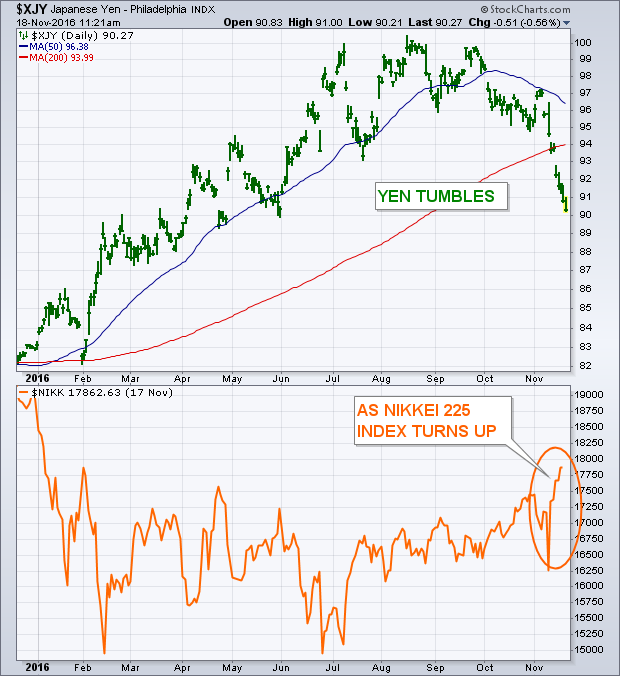 DXJ OUTPACES EWJ... As I've explain in the past, foreign stock ETFs traded here in the states are quoted in U.S. dollars. As a result, they tend to do worse when the dollar is rising against the local currency (like the yen). Since October 1, for example, Japan iShares (EWJ) have actually lost value (-1.5%) despite a nearly 10% gain in Japanese stocks. By comparison, the Wisdom Tree Japan Hedged Equity ETF (DXJ) has gained 10% over the same time span. The difference between the two Japanese stock ETFs is mainly an -8% drop in the yen. Chart 2 plots a ratio of the DXJ divided by the EWJ since the start of the year. The ratio started rising during October as the yen started to drop, and has risen to the highest level in nearly eight months (meaning the DXJ is doing much better than the EWJ). That's because the DXJ hedges out the negative effect of a falling yen. The same principle holds when investing in other foreign markets. This week's upside breakout in the dollar increases the need for hedging out the negative effect of falling foreign currencies when buying foreign stocks.
DXJ OUTPACES EWJ... As I've explain in the past, foreign stock ETFs traded here in the states are quoted in U.S. dollars. As a result, they tend to do worse when the dollar is rising against the local currency (like the yen). Since October 1, for example, Japan iShares (EWJ) have actually lost value (-1.5%) despite a nearly 10% gain in Japanese stocks. By comparison, the Wisdom Tree Japan Hedged Equity ETF (DXJ) has gained 10% over the same time span. The difference between the two Japanese stock ETFs is mainly an -8% drop in the yen. Chart 2 plots a ratio of the DXJ divided by the EWJ since the start of the year. The ratio started rising during October as the yen started to drop, and has risen to the highest level in nearly eight months (meaning the DXJ is doing much better than the EWJ). That's because the DXJ hedges out the negative effect of a falling yen. The same principle holds when investing in other foreign markets. This week's upside breakout in the dollar increases the need for hedging out the negative effect of falling foreign currencies when buying foreign stocks.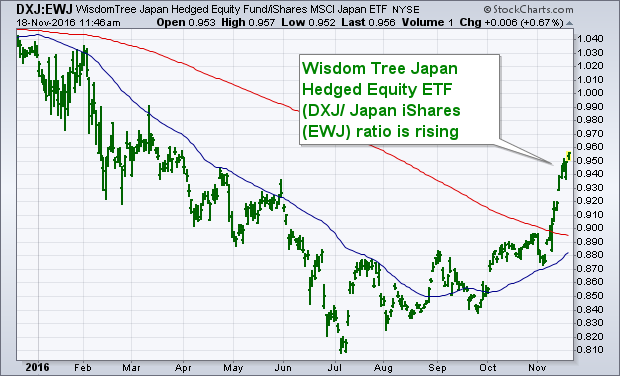

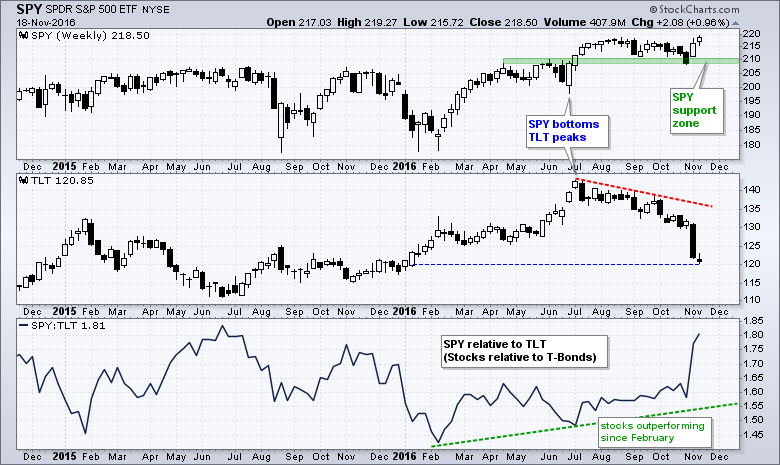
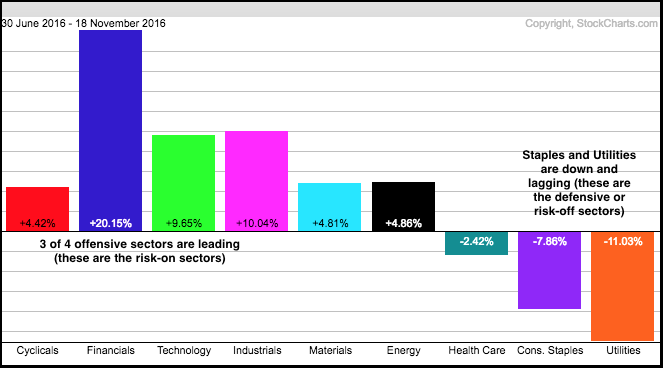

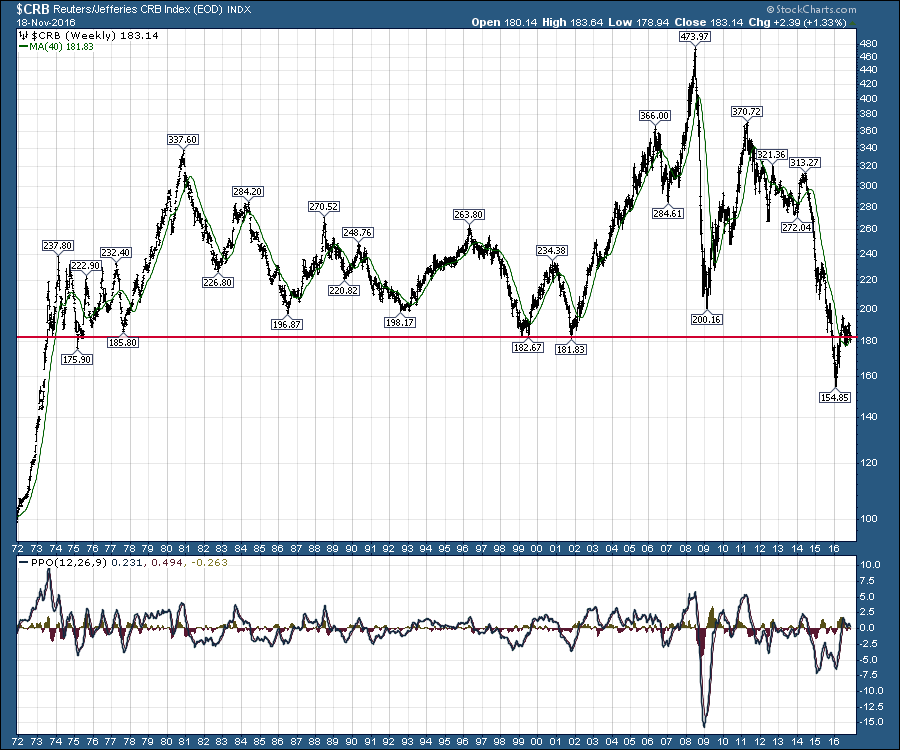


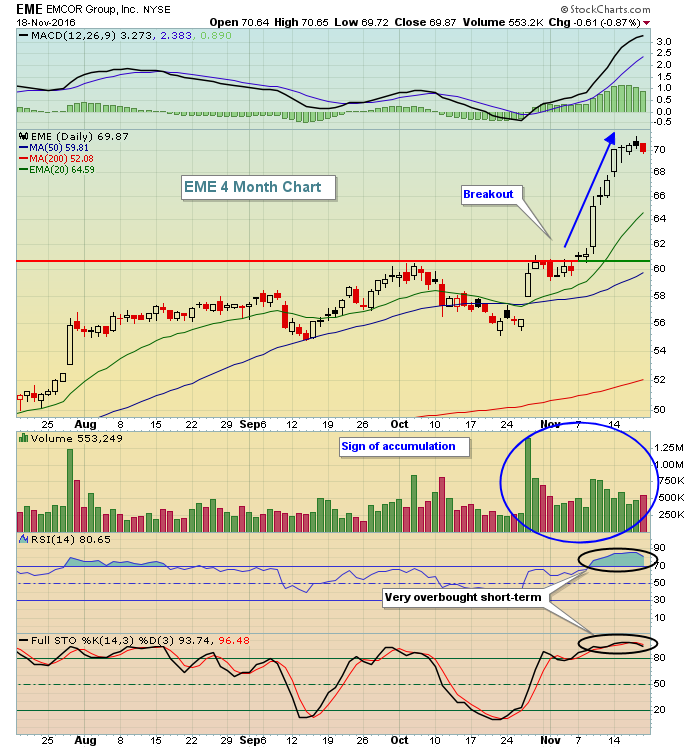


 Just look at what small cap stocks have done since the November 3 bottom. The Russell 2000 has risen 13.5%. On top of that stochastics are now close to 100 with a RSI at 74. These are levels that almost always indicate a near term top is near.
Just look at what small cap stocks have done since the November 3 bottom. The Russell 2000 has risen 13.5%. On top of that stochastics are now close to 100 with a RSI at 74. These are levels that almost always indicate a near term top is near.